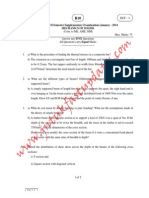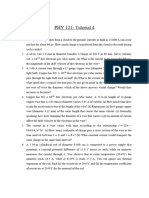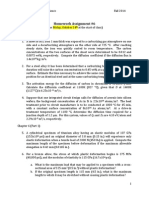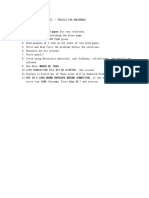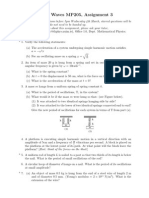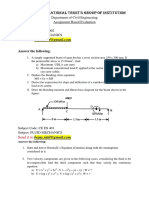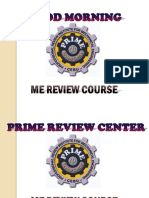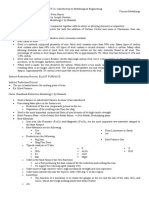Direction:: QUIZ 4 Part 1
Direction:: QUIZ 4 Part 1
Uploaded by
Fabie BarcenalCopyright:
Available Formats
Direction:: QUIZ 4 Part 1
Direction:: QUIZ 4 Part 1
Uploaded by
Fabie BarcenalOriginal Title
Copyright
Available Formats
Share this document
Did you find this document useful?
Is this content inappropriate?
Copyright:
Available Formats
Direction:: QUIZ 4 Part 1
Direction:: QUIZ 4 Part 1
Uploaded by
Fabie BarcenalCopyright:
Available Formats
QUIZ 4 Part 1
April 5, 2021
9am – 11am
Direction: Solve and show your complete solution for each problem in a white and clean
short/long bond paper. If bond paper is not available, you may write your solutions in any
CLEAN and PRESENTABLE paper. Encircle or box your final answer. Scan or take a CLEAR
PICTURE of your solutions and answers and submit the image file or pdf in the designated
submission bin in MOLE classroom.
1. (8pts) A circular steel wire 2.00 m long must stretch no more than 0.25 cm when a tensile force of 400
N is applied to each end of the wire. What minimum diameter, in mm, is required for the wire? Express
your answer into 2 decimal places.
2. (15 pts) A vertical, solid steel post 25 cm in diameter and 2.50 m long is required to support a load of
8000 kg. You can ignore the weight of the post. What are
(a) the stress in the post;
(b) the strain in the post; and
(c) the change in the post's length when the load is applied?
3. (10pts) A steel cable with cross-sectional area 3.00 cm2 has an elastic limit of 2.40 X 108 Pa. Find the
maximum upward acceleration that can be given a 1200-kg elevator supported by the cable if the
stress is not to exceed one-third of the elastic limit.
4. (15pts) A proud deep-sea fisherman hangs a 65.0-kg fish from an ideal spring having negligible mass.
The fish stretches the spring 0.120 m.
(a) Find the force constant of the spring.
The fish is now pulled down 5.00 cm and released.
(b) What is the period of oscillation of the fish?
(c) What is the maximum speed it will reach?
5. (20pts) A uniform, solid metal disk of mass 6.50 kg and diameter 24.0 cm hangs in a horizontal plane,
supported at its center by a vertical metal wire. You find that it requires a horizontal force of 4.23 N
tangent to the rim of the disk to turn it by 3.34°, thus twisting the wire. You now remove this force and
release the disk from rest.
(a) What is the torsion constant for the metal wire?
(b) What are the frequency and period of the torsional oscillations of the disk?
(c) Write the equation of motion for θ(t) for the disk.
You might also like
- 621 - Strength of Mate - BEG256CI - Civil - IIIDocument2 pages621 - Strength of Mate - BEG256CI - Civil - IIIMadrid A-ameer TamangNo ratings yet
- Direction:: QUIZ 4 Part 2Document1 pageDirection:: QUIZ 4 Part 2Fabie BarcenalNo ratings yet
- Government College of Engineering, Jalgoan: Instructions To CandidatesDocument3 pagesGovernment College of Engineering, Jalgoan: Instructions To CandidateschupchapNo ratings yet
- ProblemsDocument3 pagesProblemssosoayman484No ratings yet
- Ycmou Ast PQP t35 s05 200808 RevisedDocument2 pagesYcmou Ast PQP t35 s05 200808 Revisedphase_shekhar21No ratings yet
- Mech280final 2011Document16 pagesMech280final 2011manrabrarNo ratings yet
- SOM Test QuestionDocument3 pagesSOM Test QuestionSathis KumarNo ratings yet
- Mechanics of SolidsDocument8 pagesMechanics of Solidsprashanthreddy26No ratings yet
- PartDocument9 pagesPartMahendranath Ramakrishnan0% (2)
- PTU - B Tech - 2018 - 3rd Semester - Dec - 56004 SOLID MECHANICSDocument2 pagesPTU - B Tech - 2018 - 3rd Semester - Dec - 56004 SOLID MECHANICSSHAIK NASEER AHMED 160419736120No ratings yet
- Mechanics of Solids PDFDocument8 pagesMechanics of Solids PDFprashanthreddy26No ratings yet
- SOMDocument4 pagesSOMrrameshsmit0% (1)
- Mechanical PapersDocument23 pagesMechanical PapersSachin AgrawalNo ratings yet
- Ce74-Prestressed Concrete StructureDocument1 pageCe74-Prestressed Concrete StructureRamesh BabuNo ratings yet
- Me 2254 ModelDocument2 pagesMe 2254 Modeldevarajs2010No ratings yet
- PHY 121 Tutorial 4Document2 pagesPHY 121 Tutorial 4Siiveh DlaminiNo ratings yet
- Calculations On Stress Strain Young ModDocument2 pagesCalculations On Stress Strain Young ModMichaelKipronoNo ratings yet
- Course File Without Lecture NotesDocument56 pagesCourse File Without Lecture NotesweldharishNo ratings yet
- Strength of Materials PDFDocument8 pagesStrength of Materials PDFkalirajgurusamyNo ratings yet
- CHPT 6 SupDocument3 pagesCHPT 6 SupAviral AgarwalNo ratings yet
- 3Document56 pages3RAM NAIDU CHOPPANo ratings yet
- QbankDocument8 pagesQbanknkchandruNo ratings yet
- ME 205-Mechanics of Materials TestDocument2 pagesME 205-Mechanics of Materials TestDaniel Deng KuolNo ratings yet
- Compilations of Board Exam Problem1 PDFDocument65 pagesCompilations of Board Exam Problem1 PDFJevan Calaque100% (1)
- Simple Stresses and Strains: Strength of MaterialsDocument7 pagesSimple Stresses and Strains: Strength of MaterialsAnand AnjuruNo ratings yet
- Solid Mechanics WorksheetDocument3 pagesSolid Mechanics WorksheetLoure ShakkeNo ratings yet
- Strength of Materials University Question PaperDocument2 pagesStrength of Materials University Question PaperSaravanan KumarNo ratings yet
- ExpectedDocument1 pageExpectedagdgaming100.mNo ratings yet
- Question Bank in DC CircuitsDocument56 pagesQuestion Bank in DC CircuitsJose Ricardo Garfin Jr.89% (9)
- HW #6Document2 pagesHW #6c_sierra340% (1)
- Assignment SOMDocument4 pagesAssignment SOMranjithkrajNo ratings yet
- Mehcanics of Solids May2004 RR 220304Document8 pagesMehcanics of Solids May2004 RR 220304Nizam Institute of Engineering and Technology LibraryNo ratings yet
- Acdc MCQDocument128 pagesAcdc MCQTopen VillacortaNo ratings yet
- LABORATORY WORK 2 and QUIZ 3 IN PHY 032Document5 pagesLABORATORY WORK 2 and QUIZ 3 IN PHY 032ispa.gutierrez.auNo ratings yet
- Sathyabama University: Register NumberDocument3 pagesSathyabama University: Register NumberDesmond ChinNo ratings yet
- ch04 PDFDocument4 pagesch04 PDFAnderson Gomez CastroNo ratings yet
- Strength of Materials - Department of Mechanical Engineering PDFDocument7 pagesStrength of Materials - Department of Mechanical Engineering PDFM.Thirunavukkarasu100% (2)
- Ce 6452 SM Int IDocument2 pagesCe 6452 SM Int Iandrw1987No ratings yet
- Assignment 3-shmDocument2 pagesAssignment 3-shmPrathamesh DashNo ratings yet
- Exercise 8.3 2020 StudentDocument2 pagesExercise 8.3 2020 StudentLiuJiewChuan100% (1)
- Iit Jee Model Paper 5Document13 pagesIit Jee Model Paper 5studysteps.in100% (1)
- 18ME404 Assignment 1Document2 pages18ME404 Assignment 1BharanitharanNo ratings yet
- Class 11th 8.1Document3 pagesClass 11th 8.1Om PatelNo ratings yet
- Som Unit 1 and 2 Question BankDocument7 pagesSom Unit 1 and 2 Question Bankrkrajesh86No ratings yet
- Answer Any Three Full Questions, Each Carries 10 Marks: Reg No.: - NameDocument10 pagesAnswer Any Three Full Questions, Each Carries 10 Marks: Reg No.: - NamegalehNo ratings yet
- Unit I SomDocument4 pagesUnit I SomVENKATESHNo ratings yet
- ESO202 HW 08 2024 04 OctDocument2 pagesESO202 HW 08 2024 04 Octnikitajhajharia.854No ratings yet
- Send It To: Sanaka Educational Trust'S Group of InstitutionDocument2 pagesSend It To: Sanaka Educational Trust'S Group of InstitutionAyan GhoshNo ratings yet
- DCDocument73 pagesDCCj De PeraltaNo ratings yet
- 2017 Dec. CE201-C Mechanics of Solids - Ktu QbankDocument2 pages2017 Dec. CE201-C Mechanics of Solids - Ktu QbankivyshamjuNo ratings yet
- Som Strength of Material Question BankDocument16 pagesSom Strength of Material Question BankarindamckbtNo ratings yet
- Som Dec 2010Document2 pagesSom Dec 2010MANOJ MNo ratings yet
- 21Document15 pages21Muzamil ShahNo ratings yet
- Som Model QP N SchemeDocument2 pagesSom Model QP N Schemesihefer203No ratings yet
- Electronic and Magnetic Materials 1 HW 1Document3 pagesElectronic and Magnetic Materials 1 HW 1Maryam Allayne AbastasNo ratings yet
- MD PPT For Review-1Document78 pagesMD PPT For Review-1Victor CapistranoNo ratings yet
- ME 2254 - STRENGTH OF MATERIALS Nov - Dec 2010Document3 pagesME 2254 - STRENGTH OF MATERIALS Nov - Dec 2010Punitha KumarNo ratings yet
- O level Physics Questions And Answer Practice Papers 2From EverandO level Physics Questions And Answer Practice Papers 2Rating: 5 out of 5 stars5/5 (1)
- Quiz3PartII - AnswerKey For Part A and Part BDocument10 pagesQuiz3PartII - AnswerKey For Part A and Part BFabie BarcenalNo ratings yet
- Answer On Question 57878, Physics, Mechanics, RelativityDocument3 pagesAnswer On Question 57878, Physics, Mechanics, RelativityFabie BarcenalNo ratings yet
- Reaction Paper On Manila, Queen City of The PacificDocument7 pagesReaction Paper On Manila, Queen City of The PacificFabie Barcenal100% (1)
- Reaction Paper On Mojares ReportDocument10 pagesReaction Paper On Mojares ReportFabie Barcenal100% (1)
- Notes For 3rd Exam (Ferrous Metallurgy)Document2 pagesNotes For 3rd Exam (Ferrous Metallurgy)Fabie BarcenalNo ratings yet
- 2.5 The Mean Value Theorem PDFDocument2 pages2.5 The Mean Value Theorem PDFFabie BarcenalNo ratings yet
- Assignment 1Document1 pageAssignment 1Fabie BarcenalNo ratings yet
- Globalization As An ExperienceDocument2 pagesGlobalization As An ExperienceFabie Barcenal100% (1)
- 2.2 Implicit Differentiation and Higher Order DerivativesDocument7 pages2.2 Implicit Differentiation and Higher Order DerivativesFabie Barcenal100% (2)
- Module 1 Limits and ContinuityDocument35 pagesModule 1 Limits and ContinuityFabie BarcenalNo ratings yet
- Calculus With Analytic Geometry I: (Derivative of A Function)Document39 pagesCalculus With Analytic Geometry I: (Derivative of A Function)Fabie BarcenalNo ratings yet
- 2.3 Indeterminate Forms and L'Hopital's RuleDocument15 pages2.3 Indeterminate Forms and L'Hopital's RuleFabie Barcenal100% (1)
- 2.1 Derivatives of Algebraic and Transcendental FunctionsDocument15 pages2.1 Derivatives of Algebraic and Transcendental FunctionsFabie BarcenalNo ratings yet
- Best Practices of The Minerals Industry in Addressing The 17 SDGs - Barcenal, F. M., Jr.Document33 pagesBest Practices of The Minerals Industry in Addressing The 17 SDGs - Barcenal, F. M., Jr.Fabie BarcenalNo ratings yet
- Department of Materials and Resources Engineering & TechnologyDocument1 pageDepartment of Materials and Resources Engineering & TechnologyFabie BarcenalNo ratings yet
- Midterm - Unit Operations, Surface Mining (Notes)Document9 pagesMidterm - Unit Operations, Surface Mining (Notes)Fabie BarcenalNo ratings yet
- ES 61 Introduction and Lesson 1Document40 pagesES 61 Introduction and Lesson 1Fabie BarcenalNo ratings yet
- Method of JointsDocument10 pagesMethod of JointsFabie BarcenalNo ratings yet
- Colors and Body Parts in JapaneseDocument4 pagesColors and Body Parts in JapaneseFabie BarcenalNo ratings yet
- ES 61 Lesson 2Document6 pagesES 61 Lesson 2Fabie BarcenalNo ratings yet
- Analysis of StructuresDocument12 pagesAnalysis of StructuresFabie BarcenalNo ratings yet







